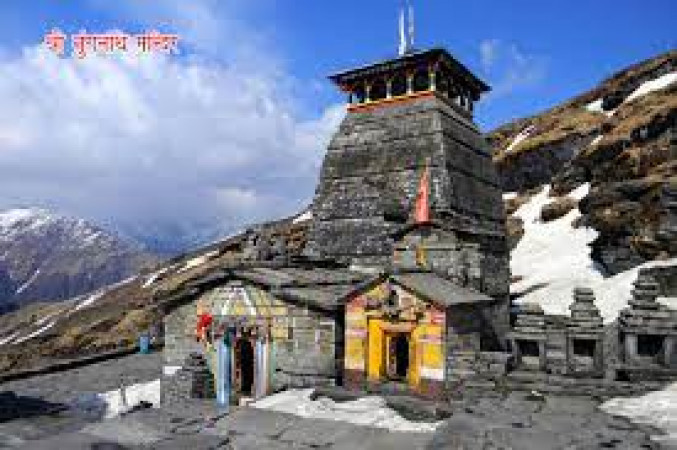
Tungnath Temple
Chopta . Uttarakhand . India
Duration
1 to 2 Days
1 to 2 Days
Best time to visit
May-Jun, Sep-Oct
May-Jun, Sep-Oct
Theme
Religious, Hill Station
Religious, Hill Station
Tungnath Temple Travel Guide
Tungnath Temple, located in the Indian state of Uttarakhand, is the highest Shiva temple in the world. Nestled in the Garhwal Himalayas at an altitude of 3,680 meters, this ancient temple holds great religious significance and offers breathtaking views of the surrounding peaks. The temple is believed to be over 1000 years old and attracts pilgrims and trekkers alike. Tungnath Temple is a popular destination for those seeking spiritual solace and adventure in the lap of the Himalayas.Top Attractions in Tungnath Temple
- Tungnath Temple
- Chandrashila Peak
- Deoria Tal
- Kanchula Korak Musk Deer Sanctuary
- Ukhimath
Tungnath Temple is Famous for
Being the highest Shiva temple in the world.Top Attractions in Tungnath Temple
- Visit the ancient Tungnath Temple
- Trek to Chandrashila Peak for panoramic views
- Explore the serene Deoria Tal lake
- Spot rare wildlife at Kanchula Korak Musk Deer Sanctuary
- Experience the tranquility of Ukhimath village
What's Great about Travelling to Tungnath Temple?
- Spiritual experience for pilgrims
- Adventure activities for trekkers
- Stunning views of the Himalayas
What's Not So Great about Travelling to Tungnath Temple?
- High altitude may cause altitude sickness
- Limited accommodation options
- Weather can be unpredictable
Travel Tips for Tungnath Temple
- Carry sufficient warm clothing and trekking gear
- Acclimatize properly to the high altitude
- Respect the religious customs at the temple
Important Tungnath Temple trip information
- Ideal Duration: 2-3 days
- Best Time to Visit: May to June and September to October
- Nearby Airports and Railway Stations: The nearest airport is Jolly Grant Airport in Dehradun, and the nearest railway station is in Rishikesh.
FAQ's on Tungnath Temple
Q1: What is the best time to visit Tungnath Temple?
The best time to visit Tungnath Temple is during the summer months from May to June and the autumn months of September to October. The weather during these times is pleasant, making it ideal for trekking and exploring the temple. Avoid visiting during the monsoon season from July to August due to heavy rainfall and in winter from November to April when the temple is usually covered in snow.
Q2: Do I need a visa to travel to Tungnath Temple?
As Tungnath Temple is located in India, tourists from most countries will require a valid tourist visa to visit. Make sure to check the specific visa requirements based on your nationality and duration of stay. Visitors from certain countries may be eligible for e-visas or visa-on-arrival facilities, but it is essential to confirm this before planning your trip.
Q3: What are the must-visit attractions in Tungnath Temple?
The top attractions in Tungnath Temple include the Tungnath Temple itself, known as the highest Shiva temple in the world, and the Chandrashila Summit offering breathtaking views of the Himalayas. Other must-visit places include Deoria Tal, Chopta, and the trekking trails around the temple, providing a serene and spiritual experience for travelers.
Q4: Is Tungnath Temple a safe place to travel?
Tungnath Temple is generally considered a safe destination for travelers. However, it is advisable to trek with a guide, especially in remote areas, and be cautious of altitude sickness due to the temple's high elevation. It is recommended to check weather conditions before trekking and to follow safety guidelines provided by local authorities.
Q5: What is the local currency in Tungnath Temple and can I use credit cards?
The local currency in Tungnath Temple is the Indian Rupee (INR). While credit cards may not be widely accepted in the remote areas around the temple, it is advisable to carry sufficient cash for transactions. ATMs are available in nearby towns like Ukhimath and Chopta, so it is recommended to withdraw cash before heading to the temple.
Q6: What is the local cuisine like in Tungnath Temple?
The local cuisine in Tungnath Temple and its surrounding areas offers a variety of dishes influenced by Garhwali and Kumaoni traditions. Popular dishes include Rajma Chawal, Aloo Ke Gutke, and Mandua ki Roti. Vegetarian options are prevalent, and travelers with dietary restrictions can find simple and delicious meals prepared with local ingredients.
Q7: What transportation options are available in Tungnath Temple?
Transportation options in Tungnath Temple include public buses, shared jeeps, and taxis to reach the base camp at Chopta. From there, the temple is accessible by a trek of about 3.5 kilometers. Additionally, travelers can hire local guides or mules for the trek. Private cars or rental services are also available for those who prefer a more personalized journey.
Q8: Are there any cultural norms or etiquette I should be aware of when visiting Tungnath Temple?
When visiting Tungnath Temple, it is important to dress modestly and respectfully, covering shoulders and knees. Removing shoes before entering the temple premises is customary, and photography may be restricted in certain areas. Respect for the local customs and religious practices is crucial, and visitors are encouraged to maintain a peaceful and harmonious atmosphere during their time at the temple.
Q9: I am a travel agent. How can I buy travel leads of Tungnath Temple?
Register yourself as a travel agent at agents.tripclap.com and then you can buy travel leads to Tungnath Temple once your account is approved. For more details contact our support team at +91-8069186564 or support@tripclap.com
